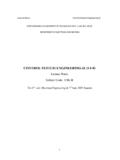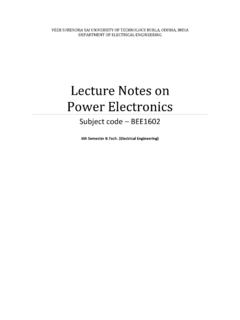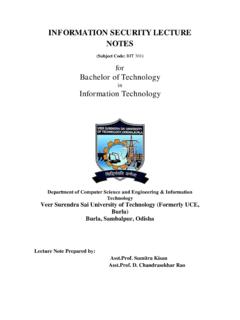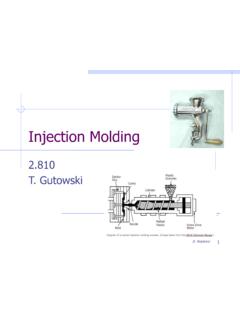Transcription of AUTOMATION & NUMERICAL CONTROL MACHINES 1.0 …
1 1 AUTOMATION & NUMERICAL CONTROL IN MANUFACTURINGMODULE-IAutomationis the technology by which a process or procedure is accomplished withouthuman assistance. It is implemented using aprogram of instructionscombined with acontrolsystemthat executes the instructions. To automate a process,power is required, both todrivethe process itself and to operate the program and CONTROL automationcan beapplied in a wide variety of areas, it is most closely associated with the manufacturing systemsoperate in the factory on the physical product. Theyperform operations such as processing, assembly, inspection, or material handling, in somecases accomplishing more than one of these operations in the same system. They are calledautomated because they perform their operations with a reduced level of human participationcompared with the corresponding manual process.
2 In some highly automated systems, thereis virtually no human participation. Examples of automated manufacturing systems include: automated machine tools that process parts transfer lines that perform a series of machiningoperations automated assembly systems manufacturing systems that use industrial robots to perform processing or assemblyoperations automatic material handling and storage systems to integrate manufacturingoperations automatic inspection systems for quality controlThus, AUTOMATION is a technology concerned with the application of mechanical, electronic,and computer-based systems to operate and CONTROL production. This technology includes: Automatic machine tools to process parts Automatic assembly MACHINES Industrial robots Automatic material handling and storage systems Automatic inspection systems for quality CONTROL Feedback CONTROL and computer process CONTROL Computer systems for planning, data collection, and decision making to supportmanufacturing OF AUTOMATED SYSTEMAn automated system consists of three basic elements:(1)powerto accomplish the processand operate the system.
3 (2)aprogram of instructionsto direct the process, and(3)acontrol system toactuate the relationship amongst these elements is illustratedin Figure All systems that qualifyas being automated include these three basicelements in one form or of anautomated system(1)Power to accomplish the automated processAn automated system is used to operate some process, and power is required to drivetheprocessas well as the controls. The principal source of power in automated power has many advantages in automated as well as non-automatedprocesses Electrical power is widelyavailableat moderate cost. Electrical power can be readily convertedtoalternative energy forms: mechanical,thermal, light, acoustic,hydraulic, and pneumatic. Electrical power at low levels can be used to accomplish functions such as signal,transmission, information processing, and data storage and communication.
4 Electrical energy can be stored in long-life batteries for use in locations where anexternalsource of electrical power is not conveniently is required in AUTOMATION for the followings: Processing operations Loading and unloadingthe work unit Material transport between operations Controller unit Power toactuate the CONTROL signals Data acquisition and information processing(2)Program of InstructionsThe actions performedinan automated process aredefined by a program of part or productstylemade in the operation requires one or more processingsteps thatare unique to that style, These processing steps are performed during a workcycle. A newpart is completed during each work cycle (in some manufacturing operations,more than onepart is produced during the work cycle; , a plastic injection molding operationmayproduce multiple parts each cycle using a multiple cavity mold).
5 The particular processingsteps for the work cycle are specified in awork cycle Cycle the simplest automated processes, the work cycle consistsofessentially one step, which is to maintain a single process parameter at a defined , the system becomes complicated when the process involves a work cycleconsisting of multiple steps with more number of process parameters are required to discrete partmanufacturing operations are in this parametersareinputs to the process such as temperature setting of a furnace,coordinate axis value in a positioning system, valve opened or closed ina fluid flow system,and motor on or off. Process parameters are distinguished fromprocessvariables,which areoutputs from the process; for example, the actual temperature of thefurnace, the actualposition of the axis, the actual flow rate of the fluid in the pipe, and therotational speed of themotor.
6 As our list of examples suggests, the changes in process parametervalues may becontinuous (gradual changes during the processingstep; for example,gradually increasingtemperature during a heat treatment cycle) or discrete (stepwisechanges; for example,on/off).The work cycle may include manual steps, where the operator performs certain activitiesduring the work cycleand theautomated system performs the rest. A common exampleis theloading and unloading of parts by the operatortoand from a numericalcontrol machinebetween machining cycles where the machine performs the cutting operationunderpartprogram CONTROL . Initiation of the cutting operation of each cycle is triggered bythe operatoractivating a "start" button after the part has been in the Programmed Work work cycles the only twofeaturesare (1) the number andsequenceof processing steps and (2) the process parameterchanges in each step.
7 Each workcycle consists of the same steps and associated processparameter changes with no variationfrom one cycle to the next. The program ofinstructionsis repealed eachwork cyclewithout deviation. In fact, many automated manufacturingoperations require decisions tobe made during the programmed work cycle to cope withvariations in the , the variations are routine elements of the cycle, and thecorresponding instructionsfor dealing with them are incorporated into the regular include: Operator the program of instructions is intended to be carriedoutwithout human interaction, the controller unit may require input data from ahumanoperator inorder tofunction. Different part or product stylesprocessed by this instance, the automatedsystem is programmed to perform different work cycles on different part orproductstyles.
8 Variationsin the starting work many manufacturing operations the startingwork units are not consistent. A good example is a sand casting as the starting workunitin a machining operation. The dimensional variations in the raw castings sometimesnecessitate an extra machining pass to bring the machined dimension to thespecifiedvalue. The part program must be coded to allow for the additional passwhen all of these examples, the routine variations can be accommodated in the regularworkcycle program. The program can be designed to respond to sensor or operator inputs byexecuting the appropriate subroutine corresponding to the cases, the variationsin the work cycle are not routine at all. They are infrequent and unexpected, suchas thefailure of an equipment component. Inthese instances, the program must include contingencyprocedures or modifications in the sequence to copewith conditions that lie outsidethenormal routine.
9 (3) CONTROL SystemThe CONTROL element of theautomated system executes the program of instructions. Thecontrol system causes the process to accomplish its defined functionwhich is to carry outsome manufacturing operation. The controlsinan automated system can be either closed loop4or open system,also known as afeedback CONTROL systemis one inwhich the output variableis compared with an input parameter, and any difference betweenthe two is used todrive the output into agreement with the shown in ,aclosed loop controlsystem consists of six basic elements: (1) input parameter, (2) process, (3)output variable, (4) feedback sensor. (5) controllerand (6) Afeedback CONTROL systemTheinput parameteroften referredto as theset point,represents the desired value of theoutput. Theprocessis the operation orfunction being controlled.
10 In particular, it is theoutputvariablethat is being controlled inthe used to measurethe output variableand close the loop between input and output. Sensors performthe feedback function in aclosed loop CONTROL system. The controllercompares the outputwith the input and makes therequired adjustmentin the process to reduce the differencebetween them. The adjustment isaccomplished using one or moreactuators,which are thehardware devices that physicallycarry out the CONTROL actions, such as an electric motor ora flow in Figure2shows only oneloop,however, most industrial processes require multiple loops, one for eachprocess variable that mustbe controlledIn contrast to the closed loop CONTROL system, anopen loop CONTROL systemoperateswithoutthe feedback loop, as in In this case, the controls operate without measuringtheoutput variableso no comparison is made between the actual value of the output and thedesired input parameter.











